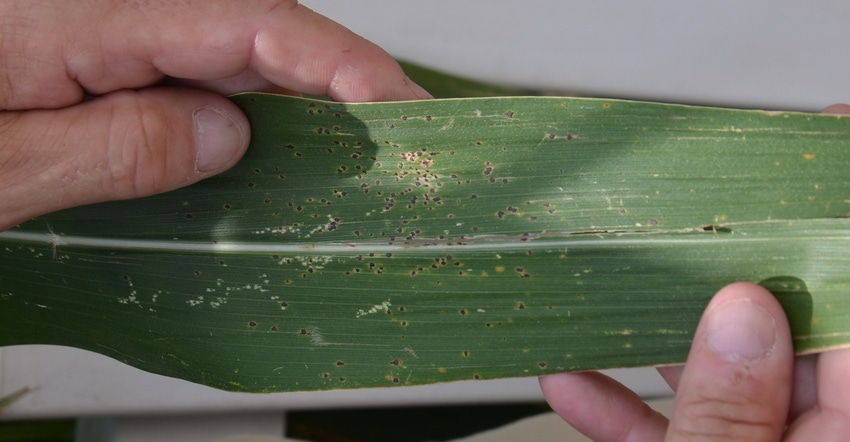
Tar spot grabs headlines for three solid reasons. It’s relatively new, it strikes hard when conditions align, and it’s spreading into new areas. Justin Petrosino, an agronomist for Stewart Seeds, urges farmers to pay attention to tar spot. However, he also urges everyone to keep their eye on all corn diseases. In many areas, gray leaf spot, northern corn leaf blight and others are still formidable foes.
“You may need to adjust your scouting practices due to tar spot,” Petrosino says. “But especially for southern parts of the eastern Corn Belt, make sure you’re scouting for gray leaf spot and other fungal diseases, too.”
The best policy is assuming inoculum for tar spot is present and watching environmental conditions, Petrosino says.
When you think diseases, you probably think warmth and heat. Tar spot prefers somewhat cooler temperatures. The other key is moisture. It needs six to eight hours of leaf wetness to initiate infection. Gray leaf spot needs about 16 hours of leaf wetness.
“Learn to recognize tar spot very early, when black dots show up on leaves. If you can’t scratch the black away with your fingernail, it’s probably a tar spot lesion,” he explains.
There is tolerance to tar spot among current genetics, but no true resistance, Petrosino explains. Screening is well underway. Once parent lines are identified, improved hybrids will be developed. He looks for the first fruit of that effort by mid-decade. Also, the search is on for native resistance traits in Mexico. Commercial products will likely appear much later.
“In the meantime, pay attention to hybrid tolerance when selecting hybrids,” Petrosino says. “There is a range of tolerance in hybrids within the industry. Pay attention to other traits, like stay-green tolerance, which may help hybrids combat these diseases better. Traits like that may not always be in seed books. Don’t be afraid to ask.
“Also, keep in mind other diseases and characteristics. Gray leaf spot is still a big deal almost every year somewhere.”
Make the most of fungicide
Fungicides vary in mode of action and effectiveness against diseases. Universities evaluate fungicides for effectiveness on specific diseases. Seek out their ratings, Petrosino suggests. Again, remember that you must control a range of diseases, not just tar spot.
“If your plan is a single application and your goal is maximum yield, spraying at R1 is still the most effective option,” he says. “Spraying at tasseling to silking in that VT to R1 timing still produces the best results over time.”
If you boil down the hype over tar spot, you’re left with following sound management practices, as for any disease, Petrosino says. In fact, your management strategy must include controlling all diseases, including gray leaf spot and southern rust, not just tar spot.
Specifically for tar spot, you may want to start scouting earlier, say around July 4, since cooler, wetter June weather could trigger it. And be ready to scout a couple of weeks longer, even after applying a fungicide. One treatment for tar spot may not be enough in years where environmental conditions favor the disease well into the fall.
Read more about:
Tar SpotAbout the Author(s)
You May Also Like




